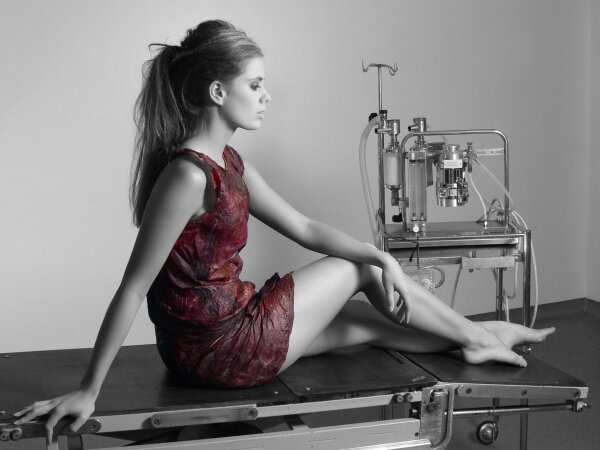Five Australian projects featured at Science Gallery
To celebrate the announcement of Science Gallery Melbourne today, we thought we'd pull together a few of our favourite Australian projects to feature in Science Gallery exhibitions over the past seven years.
1. The Body is a Big Place - Helen Pynor & Peta Clancy
The Body is a Big Place was a large-scale, immersive installation that featured in OSCILLATOR: Everything in Motion, developed through collaboration between artists, scientists and clinicians. The work explores organ transplantation and the ambiguous thresholds between life and death, revealing the process of death as an extended durational process, rather than an event that occurs in a single moment in time. As part of the installation a fully functioning heart perfusion system was used to reanimate to a beating state a pair of fresh pig hearts during a live performance. Rather than sensationalising this performative event, the artists hoped to encourage empathic responses from viewers, appealing to their somatic senses and fostering their identification with the hearts they were watching. The heart perfusion performance was accompanied by an underwater video sequence. Performers in this work are members of the organ transplant community in Melbourne, individuals who have traversed extraordinary experiences in the form of receiving, donating, or standing closely by loved ones as they receive or posthumously donate human organs. In 2012 The Body is a Big Place received an Honorary Mention in the Hybrid Arts category of Ars Electronica and was included in the ‘CyberArts’ exhibition in Linz, Austria.
Peta Clancy (now a researcher at Monash University) and Helen Pynor (who began life as a biologist and now holds a PhD from Sydney College of the Arts) have exhibited works extensively in museums, institutions and private galleries in Australia, Asia and Europe.
Watch a video from the exhibition:
2. Victimless Leather - Oron Catts & Ionat Zurr
Featured in TECHNOTHREADS: What Fashion Did Next, Victimless Leather looked at how we might obtain leather-like materials without having to slaughter animals. Using Biotechnology, the Tissue Culture & Art project garments are grown using embryonic mouse cells and human cells seeded over a biodegradable polymer substrate that has been pre-shaped in the form of the garment. As the semi-living garment grows the polymer scaffold degrades to leave the new garment.
Originally of Finnish and British origin, these adopted Aussie exhibitors work with SymbioticA, an artistic laboratory dedicated to the research, learning, critique and hands-on engagement with the life sciences based at the University of Western Australia.
Watch a video from the exhibition:
3. Prosthetic Head - Stelarc
The Prosthetic Head is an embodied conversational agent that speaks to the person who interrogates it, with real-time lip syncing, speech synthesis and facial expressions. The extensive data base of the Prosthetic Head enables it to respond adequately to personal, artistic and philosophical questions. In a way, it's a digital portrait of the artist. The creative capabilities of the Prosthetic Head include generating its own poetry and song-like sounds, which are different every time it is asked to perform. Recent developments have led to the Articulated Head, with a six-degree-of-freedom industrial robot arm. An attention model for the Articulated Head (THAMBS - Thinking Head Attention Model and Behavioural System), was developed with the Head able to perform vision tracking and sound location. Its active perception enables it to adapt to its environment and people it is interacting with. Just as a physical body exposed is inadequate, empty and involuntary, the Prosthetic Head project makes problematic notions of intelligence, awareness, identity, agency and embodiment. This project was featured in Science Gallery Dublin's HUMAN +: The Future of Our Species.
Raised in Sunshine, Melbourne, Stelarc is an artist whose work explores the capability of the human body and the "extension" of the body.
Watch a video from the exhibition:
4. Wine Dress, Micro'be' - Gary Cass & Donna Franklin
Image courtesy of Bioalloy Micro'be'
TECHNOTHREADS: What Fashion Did Next featured the next piece on our list: Wine Dress, a part of the Bioalloy laboratories at the University of Western Australia project, Micro'be'. Wine Dress is a dress cultivated from a fermented red wine solution to create a seamless, biosynthetic garment. The cotton-like material fits snugly to the body, almost like a second skin. It smells like red wine and feels like sludge when wet. A popular exhibit with the public, this piece also exhibited garments made of Guinness! Comprised of micro-fibrils of cellulose, the clothing range is very delicate and, whilst it may not be gracing a high fashion catwalk anytime soon, the intention is to allow living microbes to ferment the garments instead of using conventional weaving looms or knitting machines, redefining the production of woven materials and the raising questions about the meaning of interactions between our bodies and our clothing.
Watch a video from the exhibition:
5. The Semi-Living Worry Dolls - Oron Catts & Ionat Zurr
Another project from the immensely talented Australian team at SymbioticA, the Semi-Living Worry Dolls were the first tissue engineered sculptures to be presented alive in a gallery, and were featured by Science Gallery in VISCERAL: The Living Art Experiment. Inspired by the Guatemalan worry dolls given to children to whisper their worries and concerns to, these worry dolls were hand crafted out of degradable polymers (PGA and P4HB) and surgical sutures. The dolls are seeded with living cells that, throughout the exhibition, will gradually replace the polymers within a micro-gravity bioreactor that acts as a surrogate body. The worry dolls become partially alive. These semi-living dolls represent the current stage of cultural limbo, characterised by childlike innocence and a mixture of wonder and fear of technology. This work invites you to whisper your worries to the worry dolls—will they take your concerns away?
Watch a video from the exhibition:





